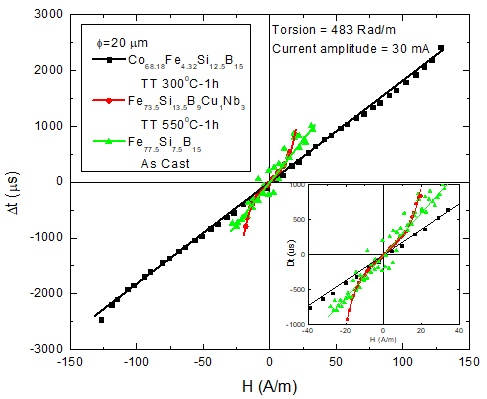Speaker
Description
Fluxgate sensors exhibit the highest sensitivity among the magnetic sensors for detecting d.c. or low frequency a.c. magnetic fields in the $\mu$T range and below. Typically, in a basic fluxgate sensor, the information about the magnetic field is extracted from either the amplitude of the induced signal or the higher-order harmonics of the excitation signal. Another alternative is to extract the field information from the residence times difference (RTD) of the induced signal peaks. However, to achieve well-defined sharp peaks in the induced signal, it is essential for the core material to possess both high magnetic permeability and fast magnetic switching capabilities. Among such materials, glass-coated microwires exhibiting large Barkhausen effect are promising for the advancement of RTD sensors. Recently, a novel technique for switching the axial magnetization in bistable glass-coated microwires has been introduced [1]: a current passing through a magnetic microwire under controlled torsion.
In this work, we present the development of the new RTD magnetic sensor, which eliminates the need for an excitation coil. The sensor consists of a soft magnetic glass-coated microwire surrounded by a pick-up coil, and an electronic system with multiple roles: to generate the excitation signal, to process the pick-up signal and to display the measured results. The sensor output signals for 3 representative categories of glass coated microwires – positive magnetostrictive amorphous Fe$_{77.5}$Si$_{7.5}$B$_{15}$, low positive magnetostrictive nanocrystalline Fe$_{73.5}$Si$_{13.5}$B$_{9}$Cu$_{1}$Nb$_{3}$, and nearly zero magnetostrictive amorphous Co$_{68.18}$Fe$_{4.32}$Si$_{12.5}$B$_{15}$ - used as sensitive elements are presented in Fig. 1. Our experiments demonstrate that annealed Co-based glass-coated microwires fluxgate sensor exhibits improved linearity in the transfer function and lower noise levels compared with Fe-based ones.

Fig. 1 The RTD sensor transfer curves measured for microwires with $\Phi$ = 20 $\mu$m and different compositions.
This sensor holds potential for applications across various domains, including digital compasses, parking sensors, magnetometers, and other detection systems that integrate magnetic sensors. Its compact design and enhanced performance make it a valuable addition to the field of magnetic sensing technology.
Acknowledgements
Financial support from the MCID Nucleu (PN 23 11 01 01 – Contract #18N/2023) Program is highly acknowledged.
References
[1] S. Corodeanu, H. Chiriac, A. Damian, N. Lupu, T.-A. Óvári, “Field and current controlled domain wall propagation in twisted glass-coated magnetic microwires”, Scientific Reports, vol. 9, article no. 5868, Apr. 2019. https://doi.org/10.1038/s41598-019-42352-1.

